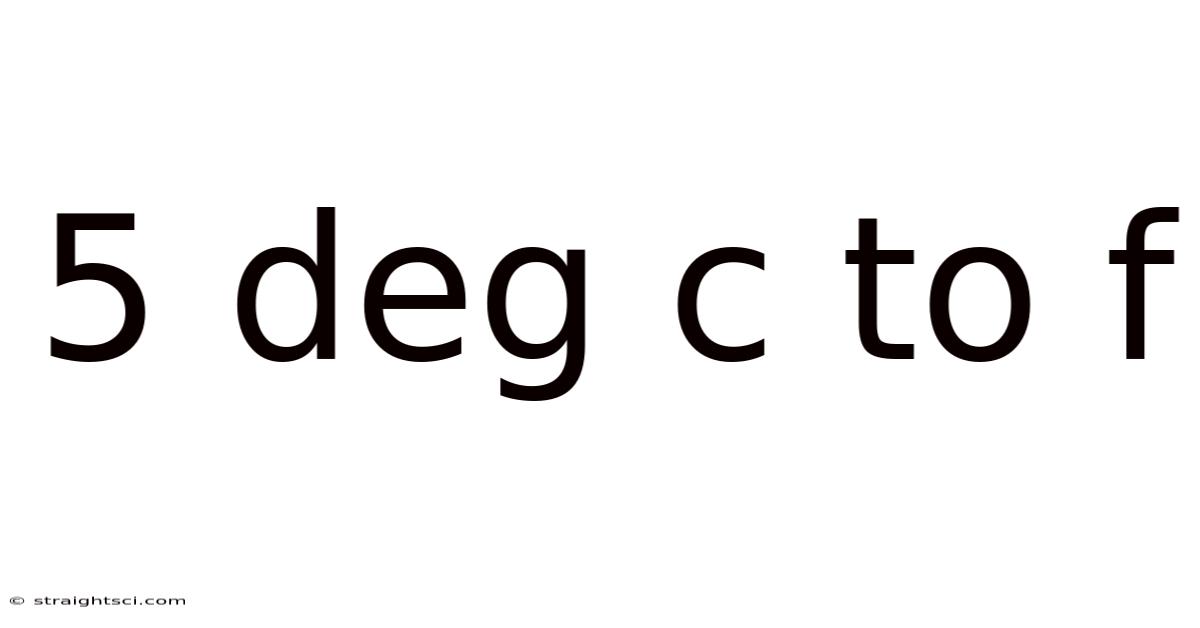5 Deg C To F
straightsci
Aug 25, 2025 · 4 min read

Table of Contents
Converting 5 Degrees Celsius to Fahrenheit: A Comprehensive Guide
Understanding temperature conversions is crucial in various fields, from cooking and weather forecasting to scientific research and engineering. This comprehensive guide will delve into the process of converting 5 degrees Celsius (°C) to Fahrenheit (°F), explaining the formula, providing step-by-step instructions, exploring the underlying scientific principles, and answering frequently asked questions. We'll also examine the practical implications of this conversion and its relevance in everyday life.
Understanding the Celsius and Fahrenheit Scales
Before diving into the conversion, let's briefly understand the two temperature scales involved. The Celsius scale (°C), also known as the centigrade scale, is a metric unit based on the freezing and boiling points of water at standard atmospheric pressure. Water freezes at 0°C and boils at 100°C.
The Fahrenheit scale (°F) is another temperature scale where water freezes at 32°F and boils at 212°F. It's still used in some countries, particularly the United States, though the Celsius scale is increasingly becoming the global standard. The difference in scale between these two systems necessitates a conversion formula to accurately translate temperatures.
The Conversion Formula: Celsius to Fahrenheit
The formula for converting Celsius to Fahrenheit is:
°F = (°C × 9/5) + 32
Where:
- °F represents the temperature in Fahrenheit.
- °C represents the temperature in Celsius.
Step-by-Step Conversion of 5°C to °F
Let's apply the formula to convert 5°C to its Fahrenheit equivalent:
Step 1: Substitute the Celsius value:
Replace °C in the formula with 5:
°F = (5 × 9/5) + 32
Step 2: Perform the multiplication:
Multiply 5 by 9/5:
°F = (9) + 32
Step 3: Add 32:
Add 32 to the result:
°F = 41
Therefore, 5 degrees Celsius is equal to 41 degrees Fahrenheit.
The Scientific Basis of Temperature Conversion
The conversion formula isn't arbitrary; it's rooted in the relationship between the Celsius and Fahrenheit scales. The factor 9/5 accounts for the different size of the degrees in each scale. There are 100 degrees between the freezing and boiling points of water on the Celsius scale and 180 degrees (212°F - 32°F) on the Fahrenheit scale. The ratio 180/100 simplifies to 9/5, reflecting the relative size of the degree increments. Adding 32 adjusts for the difference in the zero points of the two scales.
Practical Applications and Real-World Relevance
Converting between Celsius and Fahrenheit has numerous practical applications:
- Cooking: Recipes often specify temperatures in either Celsius or Fahrenheit. Accurate conversion ensures proper cooking and avoids potential food safety issues.
- Weather Forecasting: Understanding weather reports requires familiarity with both scales, as different regions might use different standards.
- Medicine: Accurate temperature readings are vital in healthcare, and conversions are necessary for consistent record-keeping and international collaboration.
- Science and Engineering: Scientific experiments and engineering projects often involve precise temperature control and measurements, making accurate conversions essential.
- Travel: When traveling internationally, it's crucial to understand the local temperature scale to dress appropriately and plan activities accordingly.
Beyond 5°C: Understanding Temperature Ranges
While this guide focuses on converting 5°C to Fahrenheit, understanding temperature conversions extends beyond a single value. It’s beneficial to grasp how different temperature ranges translate between the two scales. For example:
- Freezing Point: 0°C = 32°F
- Boiling Point: 100°C = 212°F
- Room Temperature: Approximately 20°C = Approximately 68°F
- Body Temperature: Approximately 37°C = Approximately 98.6°F
Understanding these common temperature points provides a frame of reference when interpreting temperatures in either scale.
Frequently Asked Questions (FAQ)
Q1: Is there a formula to convert Fahrenheit to Celsius?
Yes, the reverse conversion is:
°C = (°F - 32) × 5/9
Q2: Why are there two different temperature scales?
Different scales emerged historically, with Fahrenheit predating Celsius. While Celsius is now the internationally preferred standard, Fahrenheit remains in use in some countries.
Q3: Can I use an online converter for Celsius to Fahrenheit?
Yes, many online calculators and converters are available to perform this conversion quickly and accurately. However, understanding the underlying formula is important for a deeper comprehension.
Q4: What are the limitations of the conversion formula?
The formula applies to standard atmospheric pressure. At different pressures, the freezing and boiling points of water can vary slightly, impacting the accuracy of the conversion at extreme conditions.
Q5: Are there other temperature scales besides Celsius and Fahrenheit?
Yes, there are other scales, such as the Kelvin scale, which is an absolute temperature scale used extensively in scientific applications. Zero Kelvin represents absolute zero, the theoretically lowest possible temperature.
Conclusion: Mastering Temperature Conversions
Converting 5°C to Fahrenheit, as demonstrated, is a straightforward process using a simple formula. However, the significance of this conversion extends far beyond a single calculation. Understanding the underlying principles, practical applications, and limitations of the conversion process provides a valuable tool in various aspects of life, from everyday routines to scientific endeavors. Mastering this skill enhances numerical literacy and allows for a more comprehensive understanding of the world around us. By grasping the fundamentals explained in this guide, you'll be well-equipped to confidently navigate temperature conversions in any situation. Remember, the ability to convert between Celsius and Fahrenheit is not just about numbers; it's about understanding the physical world and its different measurement systems.
Latest Posts
Latest Posts
-
How To Make Dalgona Cookies
Aug 26, 2025
-
Chemical Formula For Stomach Acid
Aug 26, 2025
-
How Many Cups Is 16oz
Aug 26, 2025
-
Is Two A Prime Number
Aug 26, 2025
-
British Thermal Unit To Kilowatts
Aug 26, 2025
Related Post
Thank you for visiting our website which covers about 5 Deg C To F . We hope the information provided has been useful to you. Feel free to contact us if you have any questions or need further assistance. See you next time and don't miss to bookmark.